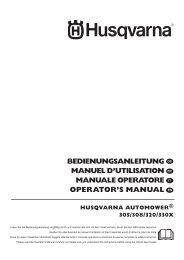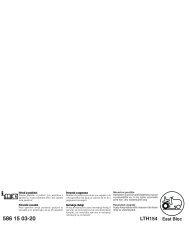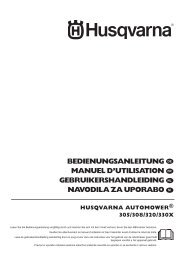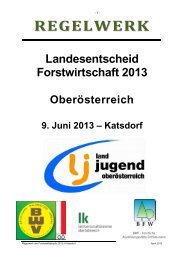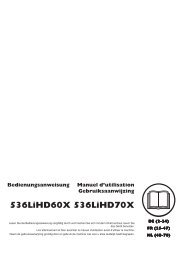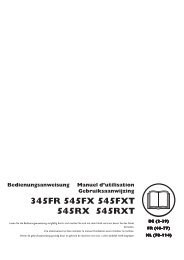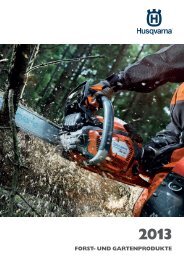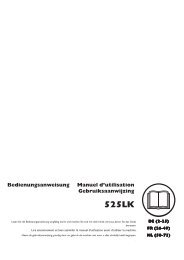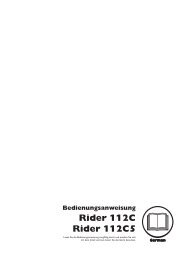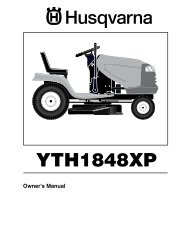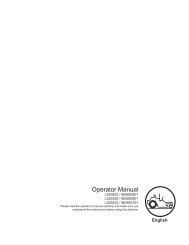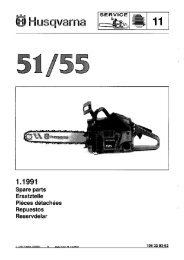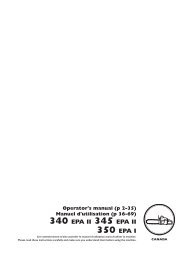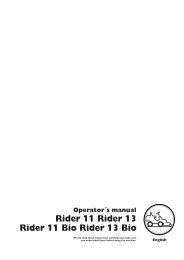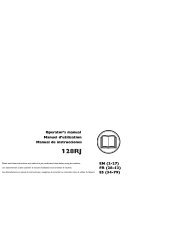om, pg530, 2007-10, lawn mowers: consumer walk ... - Husqvarna
om, pg530, 2007-10, lawn mowers: consumer walk ... - Husqvarna
om, pg530, 2007-10, lawn mowers: consumer walk ... - Husqvarna
Create successful ePaper yourself
Turn your PDF publications into a flip-book with our unique Google optimized e-Paper software.
GB<br />
ES<br />
DE<br />
FR<br />
Operator’s manual<br />
Please read the operator’s manual carefully and make sure you<br />
understand the instructions before using the machine.<br />
Manual de<br />
instrucciones<br />
Lea detenidamente el manual de instrucciones y asegúrese de<br />
entender su contenido antes de utilizar la máquina.<br />
Bedienungsanweisung<br />
Lesen Sie die Bedienungsanweisung sorgfältig durch und machen<br />
Sie sich mit dem Inhalt vertraut, bevor Sie das Gerät benutzen.<br />
Manuel d’utilisation<br />
Lire attentivement et bien assimiler le manuel d’utilisation avant<br />
d’utiliser la machine.<br />
<strong>Husqvarna</strong><br />
PG530<br />
GB ES DE FR<br />
HUSQVARNA CONSTRUCTION PRODUCTS
Contents<br />
English<br />
Contents<br />
Key to symbols 4<br />
Safety Instructions 5<br />
Introduction 6<br />
Transportation 6<br />
Storage 6<br />
What is what 7<br />
Setting up/Operation 9<br />
Changing the diamonds 11<br />
Variable speed drives/<br />
frequency converters 12<br />
Faults and troubleshooting 15<br />
Diamonds 17<br />
Diamond selection 18<br />
Maintenance 22<br />
Maintenance schedule 25<br />
Technical Data 26<br />
English - 3
Key to symbols<br />
Key to symbols<br />
The symbols below are used on the machine and in<br />
this Operator’s Manual. It is important that the user<br />
understands the signifi cance of these in order to work<br />
with the machine safely.<br />
Please read the operator’s manual<br />
carefully and make sure you understand<br />
the instructions before using the<br />
machine.<br />
Inspection and/or maintenance should<br />
be carried out with the motor switched<br />
off and the plug disconnected.<br />
WARNING! Dust forms when grinding<br />
which can cause injuries if inhaled. Use<br />
an approved breathing mask. Always<br />
provide for good ventilation.<br />
Always wear:<br />
• Approved protective helmet<br />
Visual check.<br />
Regular cleaning is required.<br />
• Approved hearing protection<br />
• Protective goggles or a visor.<br />
• Dust forms when grinding, which can<br />
cause injuries if inhaled. Use dust<br />
mask.<br />
This product is in accordance with applicable<br />
EC directives.<br />
Always wear sturdy non-slip boots with<br />
steel toe-caps.<br />
Always wear approved protective<br />
gloves.<br />
4 - English
Safety Instructions<br />
Safety Instructions<br />
WARNING<br />
Under no circumstances may the machine be<br />
started without observing the safety instructions.<br />
Should the user fail to c<strong>om</strong>ply with<br />
these, <strong>Husqvarna</strong> Construction Products<br />
Sweden AB or its representatives are free<br />
fr<strong>om</strong> all liability both directly and indirectly.<br />
Read through these operating instructions<br />
and make sure that you understand the<br />
contents before starting to use the machine.<br />
Should you, after reading these safety instructions,<br />
still feel uncertain about the safety<br />
risks involved you must not use the machine,<br />
please contact your dealer for more information.<br />
• Please read the operator’s manual carefully.<br />
• Only qualifi ed staff should be allowed to operate<br />
machinery.<br />
• Never use a machine that is faulty. Carry out the<br />
checks, maintenance and service instructions<br />
described in this manual. All repairs not covered in<br />
this manual must be performed by a repairer n<strong>om</strong>inated<br />
by either the manufacturer or distributor.<br />
• Always wear personal safety equipment such as<br />
sturdy non-slip boots, ear protection, dust mask and<br />
approved eye protection.<br />
• The machine should not be used in areas where<br />
potential for fi re or explosions exist.<br />
• Machinery should only be started when grinding<br />
heads are resting on the ground unless carrying out<br />
a testing procedure as outlined in this manual.<br />
• The machine should not be started without the<br />
rubber dust skirt attached. It is essential a good<br />
seal between machine and fl oor be established for<br />
safety, especially when operating in dry grinding<br />
applications.<br />
• When changing the grinding discs ensure power<br />
supply to the unit is OFF by engaging the Emergency<br />
Stop button and the power-plug disconnected.<br />
• The machine should not be lifted by handles, motor,<br />
chassis or other parts. Transportation of the<br />
machine is best done on a pallet/skid to which the<br />
machine must be fi rmly secured.<br />
• Never use the machine if you are tired, if you have<br />
drunk alcohol, or if you are taking medication that<br />
could affect your vision, your judgement or your coordination.<br />
• Never use a machine that has been modifi ed in any<br />
way fr<strong>om</strong> its original specifi cation.<br />
• Be on your guard for electrical shocks. Avoid having<br />
body contact with lightning-conductors/metal in the<br />
ground.<br />
• Never drag the machine by means of the cord and<br />
never pull out the plug by pulling the cord. Keep all<br />
cords and extension cords away fr<strong>om</strong> water, oil and<br />
sharp edges.<br />
• Make sure the cord is not pinched in doors, fences<br />
or the like.<br />
• Check that the cord and extension cord are intact<br />
and in good condition. Never use the machine if the<br />
cord is damaged, hand it in to an authorized service<br />
workshop for repair.<br />
• Do not use a rolled up extension cord<br />
• The machine should be connected to an earthed<br />
outlet socket.<br />
• Check that the mains voltage corresponds with that<br />
stated on the rating plate on the machine.<br />
• Ensure the cord is behind you when you start to<br />
use the machine so that the cord will not be damaged.<br />
At no time should lifting of machinery be attempted<br />
without mechanical means such as a hoist or<br />
fork lift.<br />
WARNING!<br />
Overexposure to vibration can lead to circulatory<br />
damage or nerve damage in people who<br />
have impaired circulation. Contact your doctor<br />
if you experience sympt<strong>om</strong>s of overexposure<br />
to vibration. These sympt<strong>om</strong>s include<br />
numbness, loss of feeling, tingling, pricking,<br />
pain, loss of strength, changes in skin colour<br />
or condition. These sympt<strong>om</strong>s normally appear<br />
in the fi ngers, hands or wrists.<br />
• Extreme caution must be used when moving<br />
machinery by hand on an inclined plane. Even the<br />
slightest slope can cause forces/m<strong>om</strong>entum making<br />
the machinery impossible to brake manually.<br />
English - 5
Introduction<br />
Introduction<br />
The <strong>Husqvarna</strong> PG 530 fl oor surfacing machines are<br />
designed for wet or dry grinding of marble, terrazzo,<br />
granite and concrete. Their applications range fr<strong>om</strong><br />
rough grinding through to a polished fi nish.<br />
This manual covers the <strong>Husqvarna</strong> PG 530 series of<br />
fl oor grinders equipped with twin motor drive here after<br />
referred to as Dual Drive Technology.<br />
It is extremely important all users be familiar with the<br />
contents of this manual before c<strong>om</strong>mencing operation<br />
of either machine. Failure to do so may result in damage<br />
to machinery or expose operator to unnecessary<br />
dangers.<br />
IMPORTANT!<br />
Only staff that have received the necessary<br />
education, both practically and theoretically<br />
concerning their usage should operate the<br />
machinery.<br />
IMPORTANT!<br />
The machine should not be lifted by handle,<br />
motor, chassis or other parts. Transportation<br />
of the machine is best done on a pallet/skid<br />
to which the machine must be fi rmly secured.<br />
Do not attempt to slide the tines/forks fr<strong>om</strong><br />
a fork lift under grinding heads unless on a<br />
pallet/skid. Failure to do so can cause irreparable<br />
damage to grinding heads of machine<br />
and internal parts.<br />
It is rec<strong>om</strong>mended that machinery be transported with<br />
a set of diamonds attached at all times to ensure protection<br />
of locking mechanism for diamond plates.<br />
Storage<br />
The machine should always be stored in a dry place<br />
when not in use.<br />
Transportation<br />
The machine c<strong>om</strong>es equipped with inbuilt advanced<br />
electronic systems called variable speed drives or<br />
frequency converters. These drives enable the variable<br />
speed and direction c<strong>om</strong>ponent of each of the motors.<br />
The drives are located in the steel cabinet mounted on<br />
the machine chassis.<br />
As with all electronic equipment, the drives are sensitive<br />
to excessive vibration, rough treatment and high<br />
levels of dust. Much care and attention has been given<br />
by the manufacturer to ensure maximal protection is<br />
given to the drives. Note the shock absorbing mounting<br />
system used to mount the steel cabinet on the machine<br />
chassis/ frame.<br />
When transporting, it is important to ensure the machinery<br />
is properly secured at all times to eliminate<br />
“bouncing” of the variable speed drives. Ensure the<br />
chassis or frame section of the machine is secured<br />
down at all times when in transit.<br />
The machine should always be transported under<br />
cover limiting the exposed to natural elements – in<br />
particular rain and snow.<br />
6 - English
What is what<br />
1.<br />
11.<br />
2.<br />
3.<br />
4.<br />
<strong>10</strong>.<br />
5.<br />
9.<br />
6.<br />
7.<br />
8.<br />
What is what<br />
1. Hour counter<br />
2. Electrical cabinet<br />
3. Planetary head motor 1.5kW/1Hp<br />
4. Grinding/Satellite heads motor 3kW/4Hp<br />
5. Lifting lugs<br />
6. Cover/Shroud<br />
7. Skirt<br />
8. Chassis/Frame<br />
9. Handle bars<br />
<strong>10</strong>. Control Panel<br />
11. Handle bar adjuster<br />
English - 7
What is what<br />
The machine can be divided into two main parts. These<br />
can be identifi ed as follows:<br />
1. Chassis/Frame section – c<strong>om</strong>prising handle bars,<br />
electrical cabinet, steel frame and wheels.<br />
2. Head – c<strong>om</strong>prising of motors, cover, grinding/satellite/<br />
planetary heads and internal c<strong>om</strong>ponents.<br />
The machine has been manufactured to allow movement<br />
between the chassis and head via the connection<br />
point at the lifting lugs and chassis pins. This movement<br />
is important during the grinding process as it<br />
creates a “fl oating” effect for the head.<br />
The fl oating gives the head a self-leveling effect, negating<br />
the need to adjust the height of the head as the<br />
machine passes over fl oor areas with different slopes<br />
or undulations.<br />
IMPORTANT!<br />
Planetary head and grinding heads are set<br />
to both turn in the same direction (i.e. both in<br />
clockwise rotation or both in counter-clockwise<br />
rotation).<br />
Clockwise rotation of speed control will increase<br />
speed of planetary head and grinding<br />
heads.<br />
Grinding satellite/ heads<br />
Planetary head<br />
Control panel<br />
The control panel consists of a number of switches and<br />
dials giving 6 separate controls (see picture).<br />
Power - This button, when depressed, will turn on<br />
power supply to the unit when the EMERGENCY<br />
STOP button has been released.<br />
Emergency Stop - When pushed will immediately<br />
shut down machine by totally stopping power supply to<br />
drives/ frequency converters in electrical cabinet.<br />
Dust extraction port<br />
Disc Speed - Speed control for grinding heads and<br />
planetary head.<br />
Fwd/Rev (Red) - Direction control for grinding heads<br />
and planetary head.<br />
Reset - Will clear fault function/error message on drive/<br />
frequency converter (located in electrical cabinet) in<br />
case of fault occurring.<br />
Stop/Run - To start or stop machine during normal<br />
operation.<br />
IMPORTANT!<br />
It is important to use the STOP/RUN switch<br />
to control the running of the machine, not<br />
the EMERGENCY STOP button. Each time<br />
the EMERGENCY STOP button is pressed<br />
it shuts down the drive/frequency converter.<br />
Frequently powering up and down of the<br />
drive/frequency converter will reduce the life<br />
span of the drive/ frequency converter.<br />
Control panel<br />
8 - English
Setting up/Operation<br />
Setting up/Operation<br />
Powering up machine<br />
i. Ensure the STOP/RUN switch is set on STOP<br />
(rotate counter clockwise).<br />
ii. Plug power supply to machine. Only turn power on<br />
at<br />
plug once fully connected.<br />
Position grinder on the working area. Make sure there<br />
are diamonds underneath machine and that the head<br />
locks/shear pins are tight.<br />
IMPORTANT!<br />
When using the machine, each grinding<br />
head must always have the same diamond<br />
type and number of diamonds as the other<br />
grinding heads. Each grinding head must<br />
have diamonds the same height as the other<br />
grinding heads.<br />
Adjust rubber skirt so that a good seal is established<br />
between the fl oor and head of machine (see picture<br />
below). Ensure join in skirt is at the front of the machine.<br />
Setting of the skirt is essential to obtain good<br />
dust extraction and eliminate the possibility of airborne<br />
dust when dry grinding.<br />
iii. Disengage Emergency Stop button (twist clockwise).<br />
iv. Depress Power button. On doing so, a soft “clunk”<br />
should be heard to c<strong>om</strong>e fr<strong>om</strong> within the electrical cabinet.<br />
This indicates the line contactors have engaged,<br />
supplying power to the drives/frequency converters.<br />
Setting Speed and direction<br />
On the control panel there is a FORWARD/REVERSE<br />
and Speed dial knob. Generally, when starting the<br />
machine for the fi rst time on any given application, it is<br />
advised the speed setting should not exceed 7, initially.<br />
When the operator is c<strong>om</strong>fortable with the application,<br />
speed may be increased.<br />
IMPORTANT!<br />
It is important to note the following when<br />
using the <strong>Husqvarna</strong> PG 530 single-phase<br />
grinder:<br />
Increasing the speed will also increase the<br />
current being drawn by the machine.<br />
Set handle to most c<strong>om</strong>fortable working height using<br />
adjustment lever.<br />
IMPORTANT!<br />
It is rec<strong>om</strong>mended that this height be set as<br />
close as possible to the height of the operators<br />
hip bone.<br />
When the machine is running, there will be a grinding<br />
force/pull to one side that can be felt through the<br />
handlebars. Use the hip to resist this force instead of<br />
trying to control this through the arms (such positioning<br />
will be much easier for the operator using the machine<br />
over prolonged periods of time).<br />
If on s<strong>om</strong>e applications the machine is drawing<br />
too much current and tripping current<br />
limiting switches, the speed of the machine<br />
must be reduced to c<strong>om</strong>pensate.<br />
Low voltage supplies to the grinder may result<br />
in poor performance (reduced speed and<br />
torque) of the machine.<br />
Factors which may contribute to low voltage<br />
supply to the machine include the following:<br />
- Poor mains power supply (below 220V).<br />
- Working off a generator.<br />
- Using light duty power leads (power leads<br />
with at least 2.5mm cores are highly rec<strong>om</strong>mended).<br />
- Using more than 20m (65ft) long power<br />
lead.<br />
English - 9
Setting up/Operation<br />
Speed and direction setting is often a matter of personal<br />
choice. Operators are encouraged to experiment<br />
to fi nd which settings best suit the given applications.<br />
The following table lists s<strong>om</strong>e suggested set-ups for<br />
different applications.<br />
APPLICATION DIRECTION SPEED<br />
Ceramic tile adhesive removal FWD 6-7<br />
Carpet glue removal FWD 5-7<br />
Epoxy paint removal FWD 5-<strong>10</strong><br />
Rain damaged concrete FWD 7-<strong>10</strong><br />
Smoothen exposed aggregate FWD 7-8<br />
Lippage removal in terrazzo / stone tiles FWD 5-7<br />
Concrete polishing with resin bond pads FWD <strong>10</strong><br />
PIRANHA scraper tool REV 3-5<br />
FLEXOR fl exible heads FWD 5-7<br />
Bushhammer / Scarrifi er tools FWD 5<br />
Re-grouting procedure during HiPERFLOOR<br />
process<br />
FWD 5-8<br />
Direction of rotation<br />
The correlation between FWD/REV & Clockwise/Counter<br />
clockwise rotation can be said as follows if looking<br />
at the grinding discs fr<strong>om</strong> underneath the machine:<br />
1. REV—Clockwise.<br />
2. FWD—Reverse.<br />
As mentioned, when the machine is in operation it will<br />
“pull” to one side. The direction of pull is determined by<br />
the planetary head direction of rotation. The head of<br />
the machine will pull to the right (and therefore, will be<br />
felt on the right hip of the operator) when the planetary<br />
head is set in the REVERSE direction.<br />
This sideways pull can be very useful when grinding,<br />
particularly along a wall. Set the machine so that it<br />
pulls towards the wall, and then control the machine so<br />
it can just touch the wall. This will ensure a grind close<br />
to the wall wall or object.<br />
Direction is also a matter of personal preference. It<br />
should be noted, however, that when both grinding<br />
discs and planetary heads are running in the same<br />
direction, a more powerful grinding force is created between<br />
the diamonds abrasives and fl oor being ground.<br />
The end result ishigher productivity than when the<br />
discs are set to run in opposite directions.<br />
For this reason, the machine is set so that both the<br />
grinding heads and planetary rotation are set in the<br />
same direction.<br />
Production tip - To improve the cutting effi ciency of<br />
diamonds, change directions on a regular basis. This<br />
will work both sides of the diamond crystals, keeping<br />
the abrasives as sharp as possible by creating maximal<br />
exposure of the diamond crystal.<br />
Once both speed and direction have been n<strong>om</strong>inated,<br />
switch on dust extraction or vacuum device.<br />
IMPORTANT!<br />
It is highly rec<strong>om</strong>mended to use the <strong>Husqvarna</strong><br />
DC 3300 dust extraction system for<br />
c<strong>om</strong>plete dust control.<br />
Standing behind machine with handlebars set as<br />
described earlier, apply a small amount of downward<br />
pressure on the handle. Switch the machine to run<br />
mode using the STOP/RUN switch on the control<br />
panel. The machine should start smoothly and accelerate<br />
to the selected speed over a period of 5 seconds.<br />
<strong>10</strong> - English
Changing the diamonds<br />
As different applications require different selections of<br />
diamond tools, there will be many occasions when the<br />
grinding discs need to be changed.<br />
Following is a guide for this procedure.<br />
Preparation<br />
Changing the diamonds<br />
1. Ensure STOP/RUN switch is in STOP position and<br />
the power-plug disconnected as unintentional starting<br />
of machine while changing discs can result in<br />
serious injury.<br />
2. Have a set of gloves ready, as diamonds can get<br />
very hot during dry grinding applications.<br />
Changing<br />
1. Set handle in upright position (illustrated right).<br />
2. Pull back on handle to lift grinding head off the<br />
ground.<br />
4. Lay machine back on the ground.<br />
5. Put on gloves.<br />
6. Remove grinding disc by slightly rotating disc and<br />
then pull off (direction that the discs will need to be<br />
rotated will depend on the direction the machine<br />
was last running).<br />
7. Check to ensure all head locks/shear pins are tight.<br />
8. Once new diamonds have been attached, reverse<br />
procedure to lower machine to ground.<br />
9. As new diamonds may be a different height to set<br />
being previously used, re-adjust skirt to ensure<br />
good seal is established with the fl oor.<br />
English - 11
Variable speed drives/frequency converters<br />
Variable speed drives/<br />
frequency converters<br />
Each <strong>Husqvarna</strong> PG 530 is equipped with 1 variable<br />
speed drive or frequency converter. This unit is incorporated<br />
into the machine for the following reasons:<br />
1. Functional<br />
• Manipulate inc<strong>om</strong>ing power to enable increase/<br />
decrease in speed & direction change.<br />
• Regulate current and voltage supply to the motors<br />
to ensure motors run at optimum levels (e.g. torque<br />
boost).<br />
2. Protection/Diagnostic<br />
Protection<br />
• Monitors inc<strong>om</strong>ing power to ensure suitability for<br />
machine and application being performed.<br />
1.<br />
9.<br />
• Controls current being drawn by motors to ensure<br />
motors are running within safe operational limits (to<br />
prevent damage to motor).<br />
2.<br />
• Monitors load on machine to ensure the grinder is<br />
not being overloaded thus offering protection for<br />
belt, bearings and other internal c<strong>om</strong>ponents.<br />
8.<br />
• Protects motors fr<strong>om</strong> faulty power supply (e.g. running<br />
on 2 phases).<br />
4.<br />
Diagnostic<br />
• Identifi es electrical faults with the machine and<br />
registers fault code.<br />
• Has monitoring menus that help isolate cause of<br />
potential electrical faults.<br />
• Monitoring menus also enable operator to gauge<br />
how hard machine is working. Whilst it is not essential<br />
for an operator to intimately know every feature<br />
of the variable speed drives or frequency converters,<br />
it is useful to be familiar with both the fault<br />
codes as well as s<strong>om</strong>e of the monitoring menus.<br />
Keypad/Display<br />
Each variable speed drive or frequency converter has<br />
a keypad which will appear as illustrated on the right<br />
when the machine has power connected to it.<br />
5. 3.<br />
6. 7.<br />
Keypad display<br />
1. Run direction (fwd or rev)<br />
2. Indicates if unit is either stopped or running<br />
3. Up key<br />
4. Reset button<br />
5. Left key<br />
6. Down key<br />
7. Right key<br />
8. Output mode (Hertz in this example)<br />
9. Output value<br />
12 - English
Variable speed drives/frequency converters<br />
Monitor screen<br />
OUTPUT FREQUENCY<br />
REF. FREQUENCY<br />
MOTOR SPEED<br />
MOTOR CURRENT<br />
MOTOR TORQUE<br />
MOTOR POWER<br />
MOTOR VOLTAGE<br />
DC LINK VOLTAGE<br />
Information provided<br />
Frequency motor is running at when machine is running.<br />
Frequency speed control dial is set to.<br />
Speed of motor when machine is running.<br />
Current draw of motor when machine is running.<br />
Percentage of motor torque when machine is running.<br />
Percentage of motor power when machine is running.<br />
Percentage of motor voltage when machine is running.<br />
Indicates quality of power supply.<br />
The menu tree illustrated on this page outlines the<br />
important menu options that provide useful information<br />
for monitoring and diagnostic purposes when using the<br />
machine.<br />
As can be seen on the menu tree to the right, when<br />
the machine is turned on, the variable speed drives<br />
or frequency converters are set to display the Output<br />
Frequency to the motor (a zero value will register when<br />
the machine is in stand-by mode).<br />
It can also be seen that the Output Frequency page<br />
falls under the Monitor Menu.<br />
The left hand column, highlights that the two primary<br />
menus important to the operator are the Monitor Menu<br />
and Fault History menu.<br />
Navigation through the menu tree is achieved by using<br />
the up, down, left and right keys on the keypad (see<br />
previous page).<br />
Parameter Menu<br />
Keypad<br />
Control Menu<br />
Active Faults Menu<br />
Faults History Menu<br />
System Menu<br />
DC Link Voltage<br />
Motor Voltage<br />
Motor Power<br />
Motor Torque<br />
Motor Current<br />
Expanded Boards<br />
Menu<br />
Motor Speed<br />
Monitor Menu<br />
Output Frequency<br />
English - 13
Variable speed drives/frequency converters<br />
Menus and information they provide<br />
The following menu items/screens on the variable<br />
speed drive/frequency converters provide the following<br />
useful information to the operator.<br />
OUTPUT FREQUENCY (Monitor Menu)<br />
This screen tells the operator the frequency the motor<br />
is running at when the machine is in operation. The<br />
value for output frequency should be constant when<br />
the machine is running. If there is a fl uctuation in output<br />
frequency when the machine is running, generally this<br />
indicates the motor is running at or near the limit of its<br />
programmed current limit. The current limits (predetermined<br />
and set by <strong>Husqvarna</strong> Constructions Products)<br />
are as follows:<br />
1. C<strong>om</strong>bined large and small motor - 16 amps.<br />
If there is a fl uctuation in output frequency when the<br />
machine is in operation, it is advisable to check the<br />
motor current as well. This can be found by pressing<br />
the UP arrow on the keypad 3 times. For trouble free<br />
operation concerning current issues, it is best to keep<br />
output current at or around 12-13 amps. The current<br />
draw of the motor can be reduced by reducing the<br />
speed of the motor using the speed dial on the control<br />
panel near the handle bars.<br />
MOTOR CURRENT (Monitor Menu)<br />
This screen displays the current draw of the corresponding<br />
motors. See c<strong>om</strong>ments already covered under<br />
OUTPUT FREQUENCY relating to motor current.<br />
DC LINK VOLTAGE (Monitor Menu)<br />
This screen displays the quality of the power supply<br />
to the machine. It will read higher values when the<br />
machine is in stand-by and lower values when the<br />
machine is in operation. When DC LINK voltage is<br />
reduced (in the case of a poor power supply), the variable<br />
speed drive/frequency converter will draw more<br />
current to c<strong>om</strong>pensate. This is why poor power supply<br />
will lead to the machine drawing maximum current on a<br />
premature basis (for further c<strong>om</strong>ments see page 11).<br />
FAULT HISTORY<br />
The fault history menu stores the last series of faults<br />
experienced by the variable speed drive/frequency<br />
converter. If there is a recurring fault pattern experienced<br />
by the machine, the information can be obtained<br />
fr<strong>om</strong> the fault history menu. For more on faults, see<br />
trouble shooting faults.<br />
14 - English
Faults and trouble shooting<br />
Faults and trouble shooting<br />
When either one of the variable speed drives or frequency<br />
converters in the machine experience a fault and “trip” out,<br />
they will cease to run and an error message will appear<br />
fl ashing on the keypad display (see picture below).<br />
The following list are the most c<strong>om</strong>monly experienced faults<br />
and possible action steps.<br />
Fault code<br />
Fault Code Possible Cause Action<br />
1—OVER CURRENT Motor being worked too hard and<br />
drawing extra current.<br />
Check current being drawn when machine is<br />
running. Reduce speed setting and current draw<br />
back into acceptable limits as described on<br />
previous page.<br />
3—EARTH FAULT<br />
9—UNDER VOLTAGE<br />
11—OUTPUT PHASE<br />
SUPERVISION<br />
14—UNIT OVER TEM-<br />
PERATURE<br />
Short circuit on output side of variable<br />
speed drives or frequency converters.<br />
Motor failure (very rare)<br />
Poor voltage supply to machine will<br />
result in excess current draw<br />
Short circuit on output side of variable<br />
speed drives or frequency converters.<br />
Motor failure (very rare)<br />
Insuffi cient voltage supply to machine.<br />
Power supply to variable speed<br />
drives or frequency converters has<br />
been turned off.<br />
Short circuit on output side of variable<br />
speed drives or frequency converters.<br />
Motor failure (very rare)<br />
Variable speed drives or frequency<br />
converter over temperature due to<br />
high temperature working environment<br />
or faulty temperature sensor.<br />
Check wiring in plugs connected to motor cables<br />
or inside connection boxes on motors.<br />
Have motor tested and replace if required.<br />
See c<strong>om</strong>ments on page <strong>10</strong><br />
Check wiring in plugs connected to motor cables<br />
or inside connection boxes on motors.<br />
Have motor tested and replace if required.<br />
Check power supply and ensure correct voltage.<br />
Re-connect power to grinder.<br />
Check wiring in plugs connected to motor cables<br />
or inside connection boxes on motors.<br />
Have motor tested and replace if required.<br />
Open door on electrical cabinet to increase ventilation.<br />
Have variable speed drives or frequency<br />
converter tested by service agent.<br />
15—MOTOR STALLED<br />
16 - MOTOR OVER TEM-<br />
PERATURE<br />
Motor being worked too hard and<br />
drawing extra current.<br />
Mechanical jam preventing motor<br />
fr<strong>om</strong> turning.<br />
Motor being worked too hard and<br />
drawing extra current.<br />
Check current being drawn when machine is<br />
running. Reduce speed setting and current draw<br />
back into acceptable limits as described on<br />
previous page.<br />
Try rotating grinding discs and planetary head by<br />
hand to see if jam exists<br />
Check current being drawn when machine is<br />
running. Reduce speed setting and current draw<br />
back into acceptable limits as described on<br />
previous page.<br />
English - 15
Faults and trouble shooting<br />
Further problems that may be experienced when using the grinder and potential solutions are as follows:<br />
Problem Possible Cause Potential Solution<br />
GRINDER IS HARD TO HOLD<br />
ONTO<br />
GRINDER SOUNDS LIKE IT IS<br />
OVER REVVING<br />
GRINDER IS JUMPING AROUND<br />
Not enough diamonds under the machine<br />
(if grinding thick glue or soft fl oors, too<br />
few diamonds under the machine will<br />
greatly increase the load on grinder and<br />
operator). Usually also acc<strong>om</strong>panied by<br />
high current draw by large motor.<br />
Large motor not working (this can be<br />
caused by fault with motor, fault with wiring<br />
to motor, or fault with large variable<br />
speed drive or frequency converter).<br />
Drive belt is slipping.<br />
Drive belt is broken (this can be confi<br />
rmed by turning one of the grinding<br />
heads by hand. If all grinding heads rotate<br />
together, belt is not broken. If only one<br />
grinding head turns, belt is broken).<br />
Small planetary drive motor not plugged<br />
in.<br />
Small motor not working (this can be<br />
caused by fault with motor, fault with<br />
wiring to the motor, or fault with large variable<br />
speed drive or frequency converter).<br />
Grinding heads may be worn-out or<br />
damaged.<br />
Diamonds may not be fi tted correctly or<br />
different height diamonds may be on the<br />
grinding heads.<br />
Increase number of diamonds under machine<br />
to reduce load on grinder and operator.<br />
Check large motor is plugged in. Check there<br />
are no faults on larger variable speed drive or<br />
frequency converter. Check that large variable<br />
speed drive or frequency converter is<br />
on. Check that large variable speed drive or<br />
frequency converter is functioning properly<br />
(unplug both motors, set display on keypad to<br />
Output Frequency, switch machine to RUN,<br />
see if numbers on screen change fr<strong>om</strong> zero<br />
and begin counting up. If numbers stay on<br />
zero, large variable speed drive or frequency<br />
converter is not receiving run c<strong>om</strong>mand fr<strong>om</strong><br />
switch on control panel. Machine needs to be<br />
checked by an electrician or by <strong>Husqvarna</strong><br />
Construction Products.<br />
Remove belt tensioner cover plate on bott<strong>om</strong><br />
of machine and check there is no water or dust<br />
on the inside of the machine that may be causing<br />
the belt to slip on the drive pulleys.<br />
Replace internal drive belt.<br />
Check small planetary drive motor is plugged<br />
in.<br />
Check small motor is plugged in. Check there<br />
are no faults on small variable speed drive or<br />
frequency converter. Check that small variable<br />
speed drive and frequency converter is<br />
on. Check that small variable speed drive or<br />
frequency converter is functioning properly<br />
(unplug both motors, set display on keypad to<br />
Output Frequency, switch machine to RUN,<br />
see if numbers on screen change fr<strong>om</strong> zero<br />
and begin counting up. If numbers stay on<br />
zero, small variable speed drive or frequency<br />
converter is not receiving run c<strong>om</strong>mand fr<strong>om</strong><br />
switch on control panel. Machine needs to be<br />
checked by an electrician or <strong>Husqvarna</strong> Construction<br />
Products.<br />
Check grinding heads for broken parts or<br />
excess movement.<br />
Check to ensure all diamonds are fi tted correctly<br />
and are the same height.<br />
Head locks may be loose or missing.<br />
Check to ensure all head locks are present<br />
and tight.<br />
16 - English
Diamonds<br />
Diamonds<br />
Background<br />
Diamond abrasives usually consist of 2 c<strong>om</strong>ponents:<br />
1. Diamond powder (also known as diamond crystals<br />
or grit). By changing the size of the diamond powder<br />
or grit, we can change how coarse or fi ne the<br />
scratches will be that are left behind fr<strong>om</strong> the<br />
grinding process.<br />
2. A binding agent (metal or resin). Diamond powder<br />
is mixed and suspended in either a metal or resin<br />
binding agent. When suspended in a metal binding<br />
agent, the fi nished product is referred to as a Metal<br />
Bond or Sintered diamond segment. When suspended<br />
in a resin binding agent, the fi nished product is<br />
referred to as a Resin Bond diamond segment or<br />
pad. By changing the hardness of the binding agent,<br />
we can change how fast or slow the diamond abrasive<br />
will wear.<br />
General Principles<br />
The following are general rules regarding diamond<br />
segments in grinding applications. As with all general<br />
rules there are exceptions or cases when it is not the<br />
case.<br />
DIAMOND GRIT SIZE<br />
Changing the size of the diamond grit to a smaller particle/grit<br />
size will effect the performance of the diamond<br />
tool in the following ways:<br />
• Create a fi ner scratch pattern.<br />
• Increase the life of the diamond tool.<br />
The opposite will occur when changing to a larger<br />
particle /grit size.<br />
BINDING AGENT—METAL BOND OR RESIN BOND<br />
Increasing hardness of bond will:<br />
• Increase life of diamond tool.<br />
• Decrease production rate.<br />
• Cause diamond tool to leave fi ner scratches in dry<br />
- grinding applications (when c<strong>om</strong>pared to a softer<br />
bond diamond tool with the same diamond grit<br />
size).<br />
The opposite will occur when making the metal or resin<br />
bond softer.<br />
NUMBER OF DIAMOND SEGMENTS/PADS UNDER<br />
THE MACHINE<br />
Increasing the number of segments under the machine<br />
will:<br />
• Reduce pressure on each individual diamond segment.-<br />
Reduce wear rate on diamond segments.<br />
• Reduce load on the machine and cause the grinder<br />
to draw less current.<br />
• Create a smoother scratch pattern (particularly on<br />
soft fl oors).<br />
The opposite will occur when decreasing the number<br />
of segments under the machine.<br />
WET AND DRY GRINDING<br />
When using diamond segments wet, the following<br />
principles apply:<br />
• Production rates will be higher than dry grinding.<br />
• Diamond segments will wear faster (due to presence<br />
of slurry) and therefore, harder bonds can be<br />
used (when c<strong>om</strong>paring with dry grinding).<br />
• Scratches fr<strong>om</strong> diamond grit will be deeper.<br />
When using diamond segments dry, the following<br />
principles apply:<br />
• Production rates will be slower on harder materials<br />
than if wet grinding.<br />
• Softer bond segments will be required in order to<br />
encourage segment wear (as there will be not slurry<br />
to help diamond segments to wear).<br />
• Scratches fr<strong>om</strong> diamond grit will not be as deep<br />
c<strong>om</strong>pared to if it were also used for wet grinding.<br />
• There will be more heat generated by the diamond<br />
segment.<br />
Summary of diamond principles<br />
Diamond segments need to wear in order to achieve<br />
productivity. Diamond segment wear can be infl uenced<br />
by the following factors:<br />
• Pressure.<br />
• Hardness of bond.<br />
• Diamond grit size.<br />
English - 17
Diamond selection<br />
Diamond Holder Disc<br />
Full set of single segments<br />
Half set of single segments<br />
Position for Diamond segment<br />
Full set of twin segments<br />
Half set of twin segments<br />
Diamond selection<br />
• Presence of water.<br />
• Number of segments under the machine.<br />
• Adding an additional abrasive (e.g. sand, silicone<br />
carbide) on the fl oor will increase wear.<br />
Generally speaking, the faster a diamond segment<br />
wears, the faster the productivity will be.<br />
By varying the above factors, changes can also be<br />
made to effect the following:<br />
• Scratch pattern.<br />
• Current draw of machine.<br />
• Flatness of fl oor (see next section).<br />
• Ease of operation.<br />
The following section covers important factors to<br />
consider when selecting the diamond segment you are<br />
going to use for a given application.<br />
Grinding disc set-up<br />
They way diamond segments are set-up on the grinding<br />
heads of the machine will also greatly infl uence the<br />
performance of the machine, the productivity levels and<br />
also the fi nished fl oor quality.<br />
There are basically two types of diamond confi gurations<br />
that can be used when using the grinder:<br />
1. Full set of diamonds – when there are diamonds<br />
placed at each of the six positions on the diamond<br />
holder discs (see pictures above).<br />
2. Half set of diamonds – when there are diamonds<br />
placed at three alternating positions on the diamond<br />
holder discs (see pictures above).<br />
18 - English
Diamond selection<br />
Full and half sets of diamonds<br />
By changing the way the diamonds are set-up on the<br />
diamond holder discs, an operator can signifi cantly effect<br />
the performance of the machine and therefore, the<br />
fi nished product.<br />
HALF-SET OF DIAMONDS<br />
When the diamonds are set-up as a half-set, they tend<br />
to follow the surface of the fl oor. Similar to a tripod for a<br />
camera, which can be placed on an uneven surface and<br />
yet still fi nd a stable footing.<br />
The half-set diamond confi guration should only be used<br />
when a fl at fl oor fi nish is not required.<br />
FULL-SET OF DIAMONDS<br />
When the diamonds are set-up as a full-set, they tend<br />
not to follow the surface of the fl oor. If the floor has undulations,<br />
the machine will grind the high areas yet miss<br />
the low spots (unless the high areas are ground down<br />
fi rst).<br />
The full-set diamond confi guration should be used when<br />
a fl at fl oor fi nish is desired.<br />
The below table gives s<strong>om</strong>e examples of possible applications<br />
for the two arrangements:<br />
Application Full set is best Half set is best<br />
Ceramic tile adhesive removal<br />
X<br />
Carpet glue removal<br />
X<br />
Epoxy paint removal<br />
X<br />
Vinyl adhesive removal<br />
X<br />
Rain damaged concrete<br />
X<br />
Smoothen exposed aggregate<br />
X<br />
Lippage removal in terrazzo/stone tiles<br />
X<br />
Surface polishing of concrete fl oors<br />
X<br />
Grinding to expose aggregate in concrete polishing application<br />
X<br />
Remove lippage fr<strong>om</strong> terrazzo/natural stone tiles<br />
X<br />
Flatten undulations in concrete fl oors<br />
X<br />
Re-polish fl oors that have been ground before<br />
X<br />
English - 19
Diamond selection<br />
Selecting the correct diamonds for your application<br />
The following suggestions cover the basic principles for<br />
diamond selection for different applications.<br />
Application<br />
Metal<br />
bond<br />
Grit size<br />
Flatten fl oor - Hard concrete SOFT 16 or 30 X S<br />
Flatten fl oor - Medium concrete MEDIUM 16 or 30 X S<br />
Flatten fl oor - Soft concrete HARD 16 or 30 X T<br />
Ceramic tile adhesive removal HARD 6, 16 or 30 X S/T<br />
Vinyl or Carpet glue removal - Hard concrete SOFT 16 or 30 X S/T<br />
Vinyl or Carpet glue removal - Medium concrete MEDIUM 6 or 16 X T<br />
Vinyl or Carpet glue removal - Soft concrete HARD 6 or 16 X T<br />
Epoxy paint removal - Hard concrete SOFT 6, 16 or 30 X X S<br />
Epoxy paint removal - Medium concrete MEDIUM 6, 16 or 30 X S<br />
Epoxy paint removal - Soft concrete HARD 6, 16 or 30 X S/T<br />
Rain damaged concrete HARD 16 or 30 X S/T<br />
Smoothen exposed aggregate HARD 16 or 30 X S/T<br />
Lippage removal in terrazzo - stone tiles SOFT 30 or 60 X S<br />
Surface polishing of concrete fl oors - Hard concrete SOFT 60 X S/T<br />
Surface polishing of concrete fl oors - Medium concrete MEDIUM 60 X S/T<br />
Surface polishing of concrete fl oors - Soft concrete HARD 60 X T<br />
Grinding to exposed aggregate in concrete - Hard concrete SOFT 16 or 30 X S<br />
Grinding to exposed aggregate in concrete - Medium concrete<br />
MEDIUM 16 or 30 X S<br />
Grinding to exposed aggregate in concrete - Soft concrete HARD 16 or 30 X T<br />
Flatten undulation in concrete fl oors - Hard concrete SOFT 16 or 30 X S<br />
Flatten undulation in concrete fl oors - Medium concrete MEDIUM 16 or 30 X S<br />
Flatten undulation in concrete fl oors - Soft concrete HARD 16 or 30 X T<br />
Fullset<br />
Half<br />
set<br />
Singles /<br />
Twins<br />
20 - English
Diamond selection<br />
Determining the hardness of concrete<br />
All concrete may feel hard (particularly if you fall over<br />
on it), so what do we mean when we talk about hard,<br />
medium and soft concrete?<br />
All concretes are measured by their c<strong>om</strong>pressive<br />
strength and depending on which part of the world you<br />
are fr<strong>om</strong>, different c<strong>om</strong>pressive strength indices (e.g.<br />
PSi & MPa). Generally speaking, the higher the c<strong>om</strong>pressive<br />
strength rating, the harder the concrete and<br />
therefore, the harder it will be to grind.<br />
However, other factors beside c<strong>om</strong>pressive strength<br />
ratings determine how hard the fl oor will be, and<br />
therefore, the correct diamond selection. Since grinding<br />
normally only deals with the surface of the concrete<br />
(top 5mm or 1/4 inch), often the way the concrete fl oor<br />
has been fi nished or the condition of the surface will<br />
have a greater bearing on what type of diamond to<br />
select, rather than the c<strong>om</strong>pressive strength rating of<br />
the concrete.<br />
SURFACE FACTORS TO CONSIDER WHEN MAK-<br />
ING A DIAMOND SELECTION<br />
Generally speaking, if a concrete surface is very<br />
smooth (i.e. Most likely it has been heavily trowelled/<br />
helicoptered), the concrete will behave as if it has a<br />
high c<strong>om</strong>pressive strength and therefore, require a soft<br />
bond segment.<br />
Accordingly, if a concrete surface is coarse/aggressive<br />
(e.g. rain-damaged, shot blasted, scarifi ed, exposed<br />
aggregate e.t.c.), the concrete will behave as if it has a<br />
low c<strong>om</strong>pressive strength and therefore, require a hard<br />
bond segment.<br />
Surface coatings/contaminants (e.g. Epoxy coatings,<br />
ceramic tile adhesives, levelling c<strong>om</strong>pounds/screeds)<br />
will often have a larger bearing on what diamond to select,<br />
than will the c<strong>om</strong>pressive strength of the concrete.<br />
As a general rule, when grinding a concrete slab for<br />
the fi rst time and you are unsure about its hardness,<br />
always begin with harder bond diamonds under the<br />
machine. This will ensure the least amount of wear on<br />
the diamond segments. If a hard diamond segment<br />
is not suited to the application, all it has cost is a little<br />
amount of time without wearing out the diamonds.<br />
If performed the other way around (i.e. a soft segment<br />
is used to begin with) and the concrete is soft or possesses<br />
an abrasive surface or surface contaminant, it<br />
is quite possible to wear-out a considerable amount of<br />
diamond in very short period of time.<br />
English - 21
Maintenance<br />
Maintenance<br />
Used correctly, the machine is an extremely<br />
low-maintenance and reliable.<br />
The interrelation between the above four c<strong>om</strong>ponents<br />
enables a dynamic system which is both robust and<br />
fl exible.<br />
The head pins are fi xed to the head plate giving rigidity<br />
and stability. The head mate is situated above the head<br />
plate and is held in place by a series of holes – head<br />
pin holes.<br />
This section covers the general maintenance items that<br />
need attention on a periodic basis.<br />
There are three main mechanical items to check:<br />
1. Grinding Heads.<br />
2. Planetary drive system.<br />
1.<br />
1.<br />
3. Planetary seal.<br />
Grinding heads<br />
There are 2 different grinding head options:<br />
1. Conventional/Demolition heads—designed for heavy<br />
duty preparation grinding where an extremely robust<br />
system is required.<br />
2. Spring steel head system—designed more for fi nishing<br />
or lighter grinding applications.<br />
CONVENTIONAL/DEMOLITION HEADS<br />
The below diagram illustrates the main parts c<strong>om</strong>prising<br />
this type of grinding head.<br />
2.<br />
2.<br />
1. Head mate 1. Head plate<br />
2. Head pin hole 2. Head pins<br />
Between the head plate and head mate are 3 white<br />
silicone springs which facilitate shock absorption and<br />
fl exibility in the system.<br />
The head pins are able to move within the head pin<br />
holes, creating a shock absorber type system similar to<br />
that in most motor vehicles.<br />
Over an extended period of time, the head pin holes<br />
wear open. Along with this, the head pins wear and<br />
reduce in diameter. This c<strong>om</strong>bined wearing of the two<br />
creates excessive movement or “slop” within the grinding<br />
heads. This “slop” will eventually cause vibration<br />
whilst the machine is operating.<br />
Routine checks for slop in the grinding heads are<br />
rec<strong>om</strong>mended. Life expectancy for grinding heads can<br />
vary between 6 and 12 months depending on amount<br />
of usage.<br />
Replacement heads are available and simply bolt into<br />
place when the old ones are removed.<br />
1. 2. 4. 3.<br />
1. Head mate<br />
2. Head plate<br />
3. Head lock<br />
4. Head spring<br />
22 - English
Maintenance<br />
Grinding Heads Drive System<br />
The <strong>Husqvarna</strong> PG 530 c<strong>om</strong>es equipped with Dual<br />
Drive Technology. As the grinding discs are driven<br />
by the large motor via an internal belt, and because the<br />
belt is sealed inside the machine, there is no maintenance<br />
regarding this drive system until a major service<br />
(belt and bearing replacement) is due. This is typically<br />
following 12-36 months of operation.<br />
Planetary Drive System<br />
The second c<strong>om</strong>ponent to the Dual Drive Technology<br />
system is the planetary head drive system which<br />
is powered by the secondary or small motor and<br />
gearbox arrangement. This system is on the outside of<br />
the machine and will require routine maintenance.<br />
IMPORTANT!<br />
Lubrication of this system will cause dust to<br />
build up in chain ring and drastically shorten the<br />
life of both the chain ring and planetary drive<br />
sprocket.<br />
Diagram 2 Diagram 3<br />
The planetary drive system can be seen as illustrated<br />
diagram 1.<br />
Diagram 1<br />
1. Grinding heads motor<br />
2. Motor terminal box<br />
3. Machine cover<br />
4. Gearbox mounting bracket<br />
5. Gearbox fl ange bracket<br />
6. Gearbox<br />
7. Motor terminal box<br />
8. Planetary drive motor<br />
1. 2. 1. 2. 3.<br />
1. Planetary drive sprocket<br />
2. Gearbox fl ange bracket<br />
Diagram 3<br />
1. Gearbox mounting bracket<br />
2. Machine cover<br />
3. Chain ring<br />
1.<br />
3.<br />
8.<br />
7.<br />
6.<br />
Diagram 4<br />
1. Planetary seal<br />
The chain ring and planetary drive sprocket are located<br />
beneath the cover of the machine, however on the<br />
outside of the machine, there lies the potential that they<br />
can be exposed to dust and other debris created during<br />
the grinding process. In order to prevent this as much<br />
as possible, a planetary seal has been installed to stop<br />
dust and other particles fr<strong>om</strong> c<strong>om</strong>ing into contact with the<br />
planetary drive mechanism.<br />
2. 4. 5.<br />
Diagram 1. Planetary Drive System<br />
Beneath the gearbox and concealed by the mounting<br />
brackets and machine cover, there is a planetary drive<br />
sprocket situated on the output shaft of the gearbox.<br />
This planetary sprocket engages with the chain ring<br />
(also located beneath the machine cover) and<br />
together form the main drive mechanism for the planetary<br />
drive system. This system is a dry system (i.e. it<br />
is not required for there to be lubrication between the<br />
planetary drive sprocket and chain ring), to allow any<br />
dust that may c<strong>om</strong>e into contact with the chain ring to<br />
fall back out again.<br />
Diagram 4<br />
1.<br />
Planetary seal - closeup<br />
English - 23
Maintenance<br />
The effectiveness of the planetary seal can be monitored<br />
by the simple removal of the planetary motor<br />
/ gearbox system by removing the four bolts shown<br />
below.<br />
Remove 2 bolts either<br />
side.<br />
Remove these bolts.<br />
Remove cover off motor<br />
terminal box.<br />
Inspect for dust build up<br />
here<br />
Remove these bolts.<br />
If the planetary seal is working effectively, there should<br />
be a very minimal amount of dust observed under the<br />
cover of the machine. If there is a build-up of 5-6mm<br />
(1/4 inch), then it is more than likely it is time to remove<br />
the machine cover and check the condition of the planetary<br />
seal.<br />
Remove this bolt.<br />
Lift off machine cover to reveal chain ring and planetary<br />
seal.<br />
If planetary seal is worn or needs replacement, contact<br />
your <strong>Husqvarna</strong> Construction Products distributor for a<br />
new planetary seal replacement kit.<br />
24 - English
Maintenance schedule<br />
Maintenance schedule<br />
Item Action Frequency<br />
Check that head lock<br />
are tight.<br />
Inspect heads for slop/<br />
broken “fi ngers” if using<br />
spring steel heads.<br />
Check effectiveness of<br />
planetary seal.<br />
Check condition of<br />
chain ring.<br />
Tighten head locks and re-set in thread-locking c<strong>om</strong>pound<br />
if required (Suggested thread-locking c<strong>om</strong>pound<br />
Loctite 680)<br />
Examine machine heads while machine tipped back.<br />
Disconnect Planetary Drive motor (small motor) and run<br />
discs at lowest speed. Check to see how concentric/true<br />
grinding heads are running.<br />
Remove planetary head motor/gearbox system and<br />
check for presence of dust under machine cover.<br />
Remove planetary head motor/gearbox system and inspect<br />
chain links in chain ring. Ensure links are clean and<br />
free fr<strong>om</strong> build-up.<br />
Daily<br />
Daily<br />
Weekly<br />
Weekly with Planetary Seal<br />
Check condition of<br />
Drive Sprocket.<br />
Inspect internal c<strong>om</strong>ponents<br />
of machine.<br />
Clean contents of electrical<br />
cabinet.<br />
Remove planetary head motor/gearbox system and<br />
inspect condition of planetary drive sprocket.<br />
Remove belt tensioner cover plate and check inside<br />
machine for dust, moisture or belt fragments. Ensure to<br />
re-seal cover plate with silicone sealant.<br />
Blow out inside of electrical cabinet and variable speed<br />
drives or frequency converters with DRY c<strong>om</strong>pressed air.<br />
Weekly with Planetary Seal<br />
6 monthly<br />
Every 2 months<br />
IMPORTANT!<br />
Prior to removing belt tensioner cover plate,<br />
ensure cover plate and area surrounding cover<br />
plate are totally clean. Avoid debris fr<strong>om</strong> entering<br />
into inside of machine.<br />
English - 25
Technical Data PG 530<br />
Grinding width 530mm (21")<br />
Technical Data<br />
Grinding disc 3x240mm (9.5")<br />
Weight<br />
200kg (440lbs)<br />
Grinding pressure total<br />
134kg (295lbs)<br />
Grinding pressure per disc<br />
44.7kg (98lbs)<br />
Motor Power<br />
3.75kW (5.0hp)<br />
Power per grinding disc<br />
1.25kW (1.7hp)<br />
Grinding disc speed<br />
200 - 7<strong>10</strong>rpm<br />
Planetary head speed<br />
50rpm<br />
Direction of rotation<br />
FWD/REV with grinding discs &<br />
planetary head rotation in same<br />
direction (not counter rotation).<br />
Power supply<br />
220/240 simple phase (12 amp).<br />
3 phase version available).<br />
26 - English
EC-declaration of conformity<br />
(Applies to Europe only)<br />
Technical Data<br />
<strong>Husqvarna</strong> Construction Products, SE-433 81 Göteborg, Sweden, tel: +46-31-949000, declares under sole responsibility<br />
that the <strong>Husqvarna</strong> PG530 dating fr<strong>om</strong> <strong>2007</strong> serial numbers and onwards (the year is clearly stated on the rating<br />
plate, followed by the serial number), c<strong>om</strong>plies with the requirements of the COUNCILíS DIRECTIVE:<br />
- of June 22, 1998 ”relating to machinery” 98/37/EC, annex IIA.<br />
- of May 3, 1989 ”relating to electr<strong>om</strong>agnetic c<strong>om</strong>patibility” 89/336/EEC, and applicable supplements.<br />
- of December 12, 2006 ”relating to electrical equipment” 2006/95/EC.<br />
The following standards have been applied: EN 55014-1, EN55014-2, EN6<strong>10</strong>00-3-2, EN6<strong>10</strong>00-3-3.<br />
The supplied machine conforms to the example that underwent EC type examination.<br />
Göteborg 16 July <strong>2007</strong><br />
Tim Van Der Veen, Development Manager<br />
English - 27



